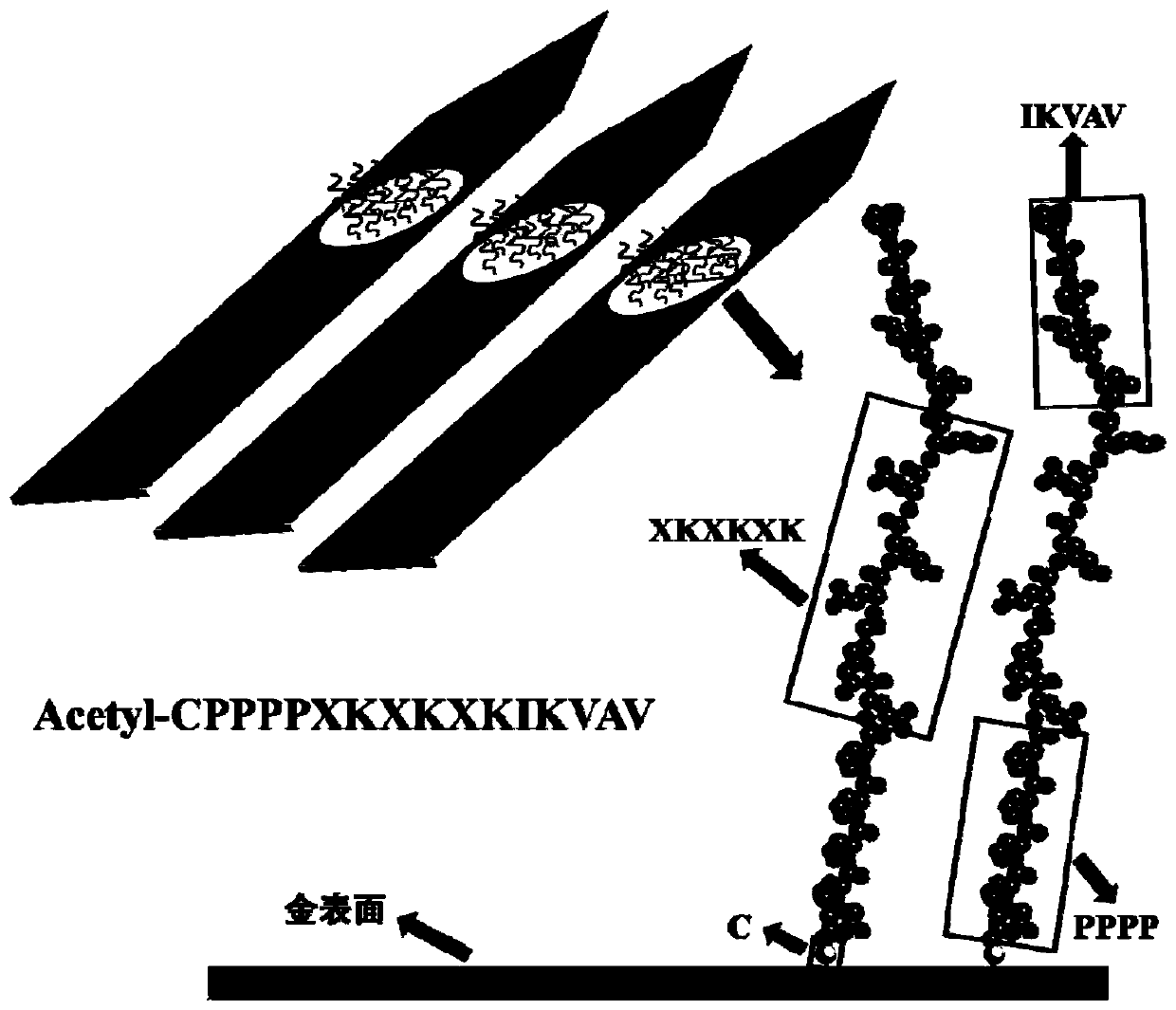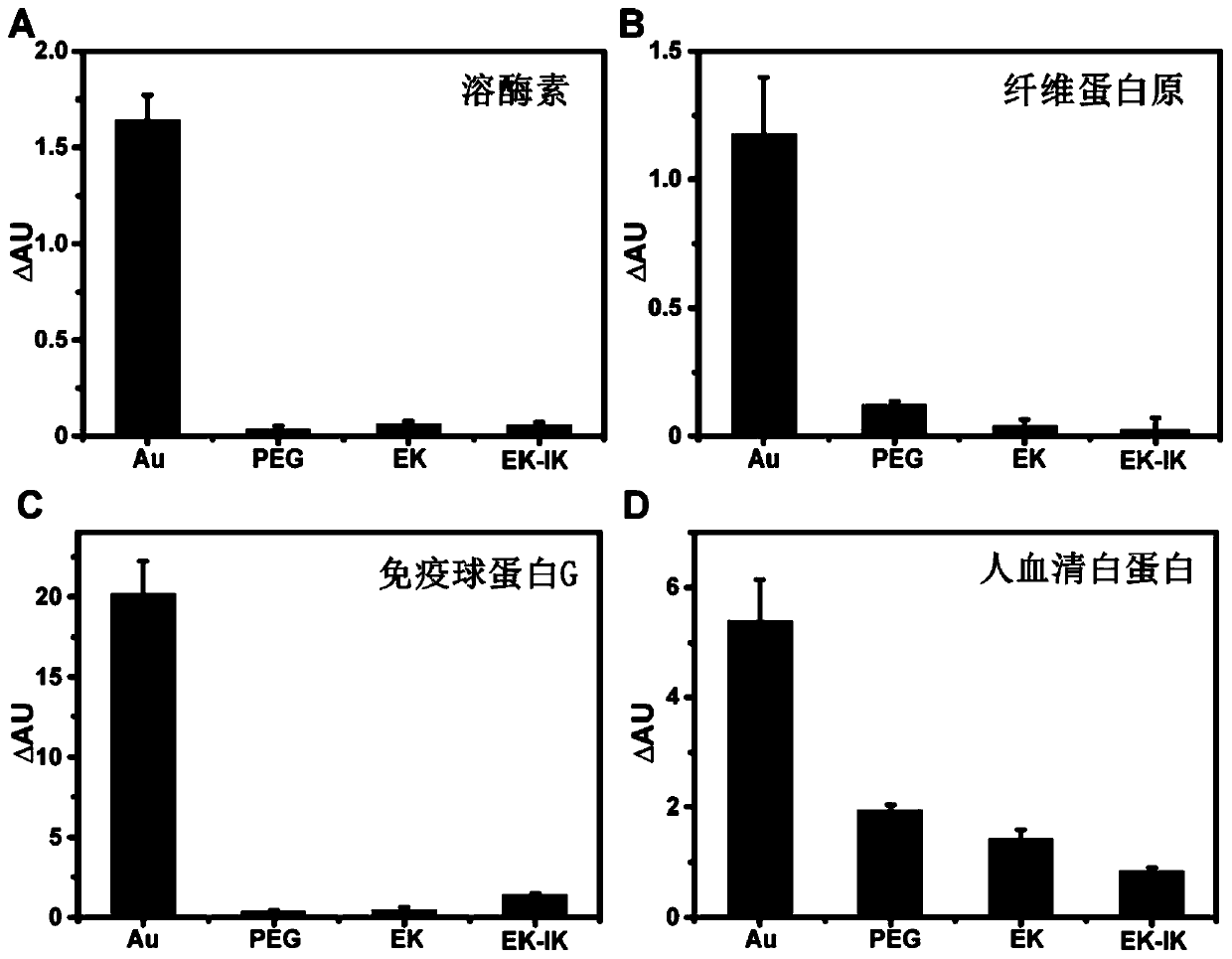Anti-pollution polypeptide, nerve electrode modified by anti-pollution polypeptide, modification method of nerve electrode and application of anti-pollution polypeptide
A peptide modification and anti-pollution technology, applied in the field of neurobiological materials and surface modification, can solve the problems of reducing protein adsorption resistance and limiting applications, and achieve the effects of enhanced interaction, guaranteed effectiveness, and increased adhesion
- Summary
- Abstract
- Description
- Claims
- Application Information
AI Technical Summary
Problems solved by technology
Method used
Image
Examples
Embodiment 1
[0064] This embodiment provides an anti-pollution polypeptide.
[0065] The anti-pollution polypeptide Acetyl-C-PPPP-EKEKEK-IKVAV (hereinafter referred to as EK-IK for short) consists of four parts, such as figure 1 As shown, the bifunctional fragments EKEKEK and IKVAV are used to resist protein adsorption and increase neuronal adhesion, the connecting segment C is used to modify the anti-pollution polypeptide to the surface of the site through gold-sulfur bonds, and the supporting segment PPPP is used to bind the two functional fragments exposed on the outside of the electrode surface.
[0066] The synthesis and modification of the polypeptides were entrusted to Hefei Guopeptide Biotechnology Co., Ltd.
Embodiment 2
[0068] In this example, the anti-adsorption ability, hydrophilicity and adhesion ability to neurons of the gold surface modified with the anti-pollution polypeptide prepared in Example 1 were tested.
[0069] (1) Anti-adsorption ability test
[0070] By surface plasmon resonance (SPR), the gold surface modified by the anti-pollution polypeptide EK-IK was tested for 1mg / mL lysozyme (Lysozyme), fibrinogen (Fibrinogen), immunoglobulin G (Immunoglobulin G, IgG ) and 2mg / mL human serum albumin (human serum albumin, HSA), the anti-adsorption ability of several typical proteins in organisms, the specific results are as follows figure 2 shown.
[0071] Simultaneously, figure 2 The anti-pollution polypeptide EK-IK is also horizontally compared in the above, and the polypeptide containing only anti-pollution function (EKEKEKEPPPPC-Am, Am is to amidate the carboxyl group of the carbon-terminal cysteine to balance the charge of the carbon-terminal, hereinafter referred to as The ad...
Embodiment 3
[0080] In this example, the anti-pollution polypeptide prepared in Example 1 is used to modify the surface sites of the flexible nerve electrode.
[0081] The flexible nerve electrode is a flexible nerve tassel electrode with 33 channels, and the specific operation steps are as follows:
[0082] (1) Pretreatment of the surface of the flexible nerve tassel electrode site
[0083] First place the flexible nerve tassel electrode in 0.5M ferric chloride, remove the aluminum sacrificial layer of the flexible nerve tassel electrode, and release the self-supporting flexible nerve tassel electrode; carefully place the nerve tassel electrode in the acetone solution to ensure that it is at the tip of the needle Immerse the electrode site area, sonicate for 30s, then quickly immerse it in isopropanol, sonicate for 30s, and then clean it with deionized water for 30s, wash away the residual acetone and isopropanol solution, and pass the three-step process The cleaning step removes non-spe...
PUM
 Login to View More
Login to View More Abstract
Description
Claims
Application Information
 Login to View More
Login to View More - R&D
- Intellectual Property
- Life Sciences
- Materials
- Tech Scout
- Unparalleled Data Quality
- Higher Quality Content
- 60% Fewer Hallucinations
Browse by: Latest US Patents, China's latest patents, Technical Efficacy Thesaurus, Application Domain, Technology Topic, Popular Technical Reports.
© 2025 PatSnap. All rights reserved.Legal|Privacy policy|Modern Slavery Act Transparency Statement|Sitemap|About US| Contact US: help@patsnap.com



